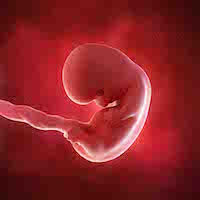9 Weeks Pregnant
At 9 weeks pregnant, things may be moving along nicely. Your body is definitely starting to change, and your baby is developing quickly. Even if you are not feeling a lot of pregnancy symptoms, a lot is happening.
What’s happening with your body?
 Your breasts have probably increased in size, and your tummy may be puffy. It is more due to hormones than your baby right now. At nine weeks, you can probably still fit into most of your regular clothes, although your skinny jeans may not be the most comfortable thing to wear.
Your breasts have probably increased in size, and your tummy may be puffy. It is more due to hormones than your baby right now. At nine weeks, you can probably still fit into most of your regular clothes, although your skinny jeans may not be the most comfortable thing to wear.
If you started to feel pregnancy symptoms a few weeks ago, they might be intensifying this week. For example, nausea often peaks between eight and 12 weeks, so at nine weeks, you may be in the thick of morning sickness. If nausea becomes severe and you are unable to keep any food or liquids down, talk with your healthcare provider as soon as possible. A small percentage of women develop severe nausea known as hyperemesis gravidarum. Anti-nausea medication may be prescribed in some cases.
Frequent peeing and fatigue may also still be your constant companion. Try to hang in there. You should get a break from constant trips to the bathroom and exhaustion during your second trimester.
Don’t worry if don’t feel many pregnancy symptoms. It does not mean anything is wrong, or your hormone levels are abnormally low. You might just be one of the lucky ones who is not sensitive to hormonal changes.
While a few symptoms may have been around for a few weeks, some things may be new. For example, some women develop frequent salivation. Producing excess saliva may be a bit embarrassing, but it’s pretty common. Excess salivation is often due to pregnancy hormones and morning sickness. Although it may be annoying, it’s harmless and should decrease as your pregnancy progresses. In the meantime, sucking on ice or hard candy may help.
What’s happening with your baby?
 Your baby is now called a fetus and has grown to about the size of an olive. Although he is still small, he is starting to take a more baby-like shape at eight weeks. For instance, his embryonic tail has disappeared, and his limbs are starting to look more proportional to the rest of his body. His head is still large in comparison to his body, but that will also change in time.
Your baby is now called a fetus and has grown to about the size of an olive. Although he is still small, he is starting to take a more baby-like shape at eight weeks. For instance, his embryonic tail has disappeared, and his limbs are starting to look more proportional to the rest of his body. His head is still large in comparison to his body, but that will also change in time.
Nerve cells inside your baby’s brain are starting to form pathways so signals can be transmitted. But it’s not just your baby’s brain that is becoming more sophisticated. Branches of his lungs are developing, and more organs are forming including the liver and spleen.
By the time you are nine weeks along, your baby’s heart is also strong enough that his heartbeat can often be detected with a handheld ultrasound device called a Doppler. If your healthcare provider does not pick up the heartbeat this early, don’t worry. It’s still a little early, and the position of your uterus may prevent your practitioner from detecting it.
Your little one is also moving a bit more, although his muscles are still too tiny for you to feel any kicks just yet. You probably won’t be able to feel any movements for several more weeks.
Things to consider
Depending on your family history and your age, you may want to discuss certain genetic tests with your doctor during your first trimester. Various screening tests are available, which can detect genetic abnormalities.
Many prenatal screenings are performed between nine and 13 weeks. Based on your medical history and ethnicity, your healthcare provider may offer you carrier screening tests to determine whether your baby is at risk for certain inherited diseases, such as sickle cell disease and cystic fibrosis.
Many practitioners also offer their patients tests to determine the likelihood of downs syndrome. Screening tests for downs syndrome involve taking ultrasound measurements and doing blood tests. The screening tests do not tell you for sure whether your baby will have downs. Instead, they provide you with the chances or likelihood your baby has the condition. Depending on the results, you may be offered more invasive tests, such as an amniocentesis or chronic villus sampling, which will provide a definitive diagnosis.